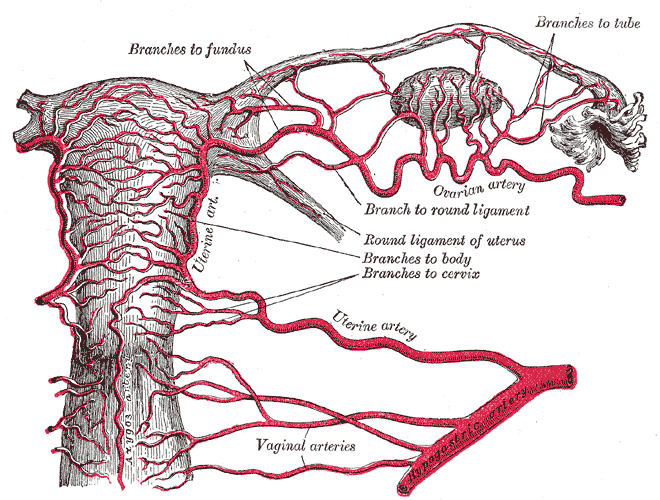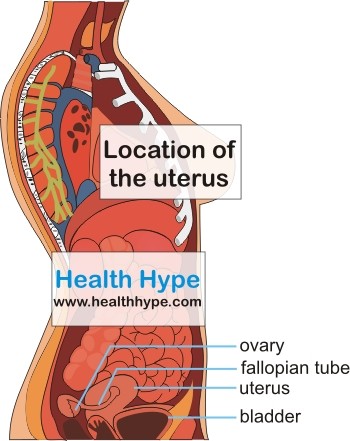Round Ligament Pain During, After Pregnancy, When Not Pregnant
What is the uterine round ligament?
There are several ligaments in the body known as the round ligament. With regard to the female reproductive system, there are two round ligaments on either side of the upper corners of the uterus. It is therefore more correctly referred to as the round ligament of the uterus or ligamentum teres uteri.
The round ligament of the uterus is a flattened band that runs from the upper corners of the uterus through the inguinal canal and to the labia majora. There is a round ligament on either side of the uterus. It is contained within a fold of peritoneum along with other structures like the fallopian tubes which are collectively referred to as the broad ligament. The round ligaments are between 10 to 12 centimeters in length. It composed of muscle tissue which is continuous with the muscular layer of the uterus, some fibrous tissue, loose connective tissue, nerves, blood vessels and lymphatics.
Picture of the round ligament from Wikimedia Commons
Function of the uterine round ligament
The lower part of the uterus is supported by fibrous tissues in the pelvis but the upper parts requires suspensory ligaments for support. The round ligament of the uterus and even the broad ligament as a whole is responsible for holding up the upper portion of the uterus. This is of particular importance in pregnancy to support the larger and heavier uterus. The elevation in female hormones with pregnancy allows for the round ligament to stretch with expansion of the uterus due to the growing fetus. The round ligament, however, is firm and not able to stretch as significantly in the non-pregnant state.
What is round ligament pain?
Round ligament pain is a type of pelvic pain associated with the round ligament of the uterus. This may occur with stretching or spasm of the ligament. It is more likely to occur in pregnancy as the uterus expands and applies more stress and tension on the ligament. However, the round ligament does not exist in isolation. The stress and tension on the round ligament may also affect surrounding structures in the broad ligament like the fallopian tubes or structures that lie in close proximity along its course to the labia majora.
Round ligament pain symptoms
Round ligament pain is symptom of stretching or spasm of the round ligament or pressure on structures around the ligament. The pain can vary from a dull ache or ‘pulling’ feeling to sharp pain. It is usually short term, brought about with excessive movement and eases to some extent with rest. Round ligament pain is most frequently seen in pregnancy. It is considered to be normal and is not an indication of any problem with pregnancy or other underlying disease. However, the presence of other symptoms may sometimes be indicative of a diseased state or even medical emergency that requires immediate attention. Warning features accompanying round ligament pain may include :
- Fever and chills
- Dizziness and fainting
- Nausea and vomiting
- Excessive perspiration
- Abnormal vaginal bleeding
Causes of round ligament pain
Round ligament pain almost always occur in pregnancy but there are instances where it is believed to occur in women after pregnancy and even in women were not recently pregnant. However, the term ’round ligament pain’ is often used loosely to describe pelvic pain that is of no clear cause. Therefore in these instances the pain may not be associated with the round ligament but rather due to underlying disorders of the female reproductive system, lower abdominal or pelvic area that has not as yet been diagnosed.
Round Ligament Pain During Pregnancy
Round ligament pain during pregnancy is a result of the ligament stretching with enlargement of the uterus. The round ligament being both muscular and firm can stretch significantly in the pregnant state due to the higher than normal levels of the female hormones like progestrone. It becomes thinner and longer as it bears bear the additional stress and tension of the expanding uterus. This stretching is gradual during the course of the pregnancy and may not elicit pain on its own. Even as the round ligament is stretched to the maximum towards the end of pregnancy, pain may not be present. It is more like to occur with quick movements that suddenly adds to the stress and tension on the round ligament.
Apart from pain due to stretching, the muscles in the ligament may also go into spasm which can result in painful cramps. However, round ligament pain does not always emanate from the round ligament itself. Sometimes the tension applied to the round ligament may press against structures lying near the ligament. In these instances, round ligament pain are considered to be normal. Some of the precipitating causes of round ligament pain includes exercise, suddenly waking up and even short episodes of strong uterine contractions seen in late pregnancy.
Round ligament pain should always be investigated further to rule out any underlying diseases in the abdominopelvic area. Pain due to an ectopic pregnancy in early pregnancy may be mistaken for round ligament pain. There are also various other causes of pelvic pain in pregnancy that should also be considered.
Round ligament pain after pregnancy
The sharp drop in hormone levels after childbirth and the shrinking of the uterus allows the round ligament to gradually return to its normal state. It once again becomes thicker and firmer than during pregnancy. The uterus then returns to its slightly forward tilting position over the bladder in the non-pregnant state. However, the uterus may sometimes tilt backwards (retroverted uterus) after childbirth. The other structures that were pushed aside or lax like the abdominal wall gradually returns to it pre-pregnancy state. The uterus may be slightly more mobile than is normally the case in women who are not pregnant. Therefore quick movements can cause movement of the uterus and result in tension on the round ligament. This stretching may cause round ligament pain as is the case in pregnant women or the muscles in the round ligament may contract excessively leading to spasms which can also cause pain.
Round ligament pain when not pregnant
In the non-pregnant state, especially in females who have never been pregnant, the round ligament is firm yet flexible enough to absorb any force that may attempt to suddenly move the uterus out of its normal position. The ligament runs from the horns of the uterus upwards, forwards and sideways thereby holding the uterus in its forward tilted position. Stretching of the round ligament in the non-pregnant state is unlikely to occur with movement unless the other organs of the abdominopelvic cavity start pushing against the uterus. Muscle spasms of the round ligament may also cause painful cramps. However, the more likely cause is associated with disorders of the organs surrounding the round ligament and particularly the organs of the female reproductive system. This pain that may not involve or originate within the round ligament can sometimes be mistaken for round ligament pain. Some conditions which may be mistaken for round ligament pain includes :
- Polycystic ovarian syndrome (PCOS)
- Endometriosis
- Pelvic adhesions
- Appendicitis
- Abdominal growths which may push against the uterus
- Severe constipation particularly with fecal impaction
Round ligament pain treatment
Round ligament pain does not require any specific treatment. Mild anti-inflammatory drugs like acetaminophen is safe to use in pregnancy within moderation. This may help ease the pain but should not be used if the pain is bearable and eases quickly on its own. Resting in a comfortable position that does not worsen the pain is advisable. Pregnant women should identify trigger factors that elicit the pain and try to avoid it as far as possible. Reducing daily activity or one’s workload in late pregnancy is also advisable. Immediate medical attention is required if the pain is persistent for long periods of time, is severe and presenting with other symptoms like vaginal bleeding, fever, dizziness or nausea and vomiting. Pelvic pain due to other causes requires the appropriate treatment.


